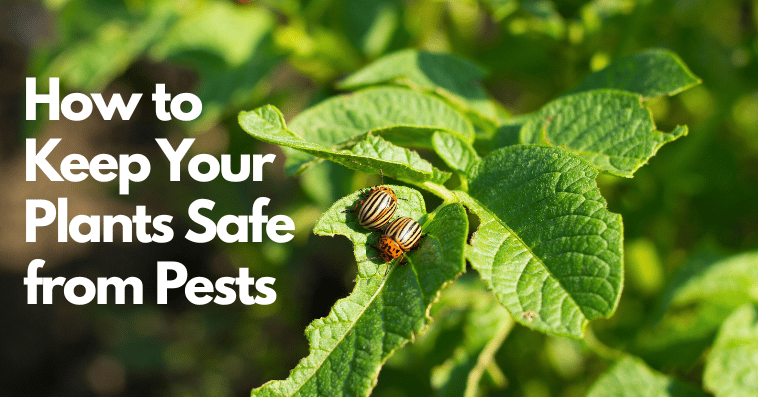A lush green garden filled with thriving plants is every gardener’s dream. But this dream can quickly turn into a nightmare when pests invade and damage your beloved plants. Whether you're nurturing a few potted herbs on your balcony or managing a full-fledged backyard garden, plant pests are a challenge you can’t ignore.
In this blog, we’ll dive deep into how to keep your plants safe from pests using smart, sustainable, and gardener-approved methods. Whether you're a beginner or a seasoned green thumb, these pest control strategies will help you safeguard your plants and encourage healthy growth.
Why Pest Control Is Essential in Gardening
Pests like aphids, mealybugs, spider mites, whiteflies, and caterpillars not only feed on plant sap but also spread diseases. If left untreated, they can stunt plant growth or even kill your plants. Implementing effective pest control for plants is not just about removing bugs — it's about creating a healthy, resilient garden ecosystem.
1. Identify the Enemy: Know Your Garden Pests
Before you treat, you need to identify. Here are some common plant pests to look out for:
Aphids: Small, soft-bodied insects found on new growth
Mealybugs: White, cotton-like insects on stems and leaves
Spider mites: Tiny red or yellow spots under leaves, often with webbing
Whiteflies: Small, white flying insects that thrive in warm conditions
Leaf Miners: Larvae that tunnel through leaves leaving trails
Look for signs like:
Yellowing leaves
Sticky residue (honeydew)
Wilting despite watering
Tiny bite marks or holes
Early detection is the key to pest control success!
2. Practice Preventive Gardening
Prevention is better than cure—especially when it comes to pests. Here’s how you can avoid infestations:
✅ Healthy Soil = Healthy Plants
Start with organic compost and well-draining soil to encourage strong roots. Healthy plants are more pest-resistant.
✅ Proper Spacing
Overcrowded plants limit airflow and create humidity—perfect for pest breeding. Give your plants room to breathe.
✅ Regular Pruning
Trim dead leaves and branches to prevent pest nesting and improve light penetration.
✅ Watering Wisely
Overwatering attracts fungus gnats and root rot, while underwatering weakens plants. Water deeply but infrequently.
3. Go Natural: Organic Pest Control Solutions
Using natural pest control for plants is safe for pets, kids, and the environment. Here are some popular methods:
🧴 Neem Oil Spray
One of the best organic pest control products, neem oil works as an insect repellent and disrupts pest life cycles. Mix with water and a few drops of dish soap to make a homemade spray.
🧄 Garlic & Chili Spray
Blend garlic, chili, and water to create a powerful DIY pest repellent. Spray on affected areas in the early morning or evening.
🪳 Soap and Water Spray
A mild soap solution can kill soft-bodied pests like aphids and mealybugs. Use only unscented, biodegradable soap.
🌿 Companion Planting
Some plants repel pests naturally. Try growing marigold, basil, lavender, or mint near pest-prone plants for protection.
4. Invite Nature’s Pest Controllers
Encouraging beneficial insects is one of the smartest garden pest control strategies.
🐞 Ladybugs
Natural predators of aphids and spider mites.
🐝 Hoverflies & Lacewings
They feed on soft-bodied insects and larvae.
To attract these helpful bugs, plant dill, fennel, cosmos, and yarrow in your garden. Avoid broad-spectrum insecticides that can harm them.
5. Avoid Chemical Overuse
While pesticides offer a quick fix, they come with risks:
Harm beneficial insects
Damage plant tissues
Contaminate soil and water
Lead to pest resistance over time
If you must use a chemical, opt for plant-safe insecticides and use them as a last resort, following label instructions carefully.
6. Special Tips for Indoor Plant Pest Control
Indoor plants need extra care since they’re in a controlled environment.
Wipe leaves regularly to prevent dust and pests.
Isolate new plants for a week before introducing them to your collection.
Use sticky traps to catch flying insects.
Keep humidity in check—overly humid homes can invite spider mites and mold.
7. Inspect Weekly and Act Immediately
Make pest inspection a weekly routine. Check under leaves, around stems, and in the soil. Catching an infestation early helps prevent spread and minimizes damage.
Use a magnifying glass if needed and take quick action by trimming infected parts and spraying natural solutions.
8. Use Protective Products
Consider investing in garden pest control tools like:
Insect netting or garden cloches
Copper tape for slug protection
Diatomaceous earth for crawling insects
Sticky traps for fungus gnats and whiteflies
These products help minimize pest access without harming the plants.
Pro Gardener Tip: Rotate Crops and Repot When Needed
If you're growing edibles like tomatoes, spinach, or mint, rotate crops each season to prevent pest build-up in the soil.
Repot indoor plants annually to refresh the soil and remove any hidden larvae or eggs.
Final Thoughts: Healthy Garden, Happy Gardener
Pest problems are inevitable in gardening—but they don’t have to ruin your plants. By staying proactive, using eco-friendly pest control methods, and nurturing your plants with love and care, you can enjoy a thriving, pest-free garden all year round.
And remember, choosing quality gardening products plays a major role in plant health.
Buy Trusted Gardening Products from PaudheWale!
Want to keep your plants safe, healthy, and pest-free? Find top-quality neem oil, organic compost, plant protectors, and companion plants all in one place at PaudheWale.
Transform your gardening journey with PaudheWale’s eco-conscious and effective solutions.
Order today and let your plants bloom pest-free!

